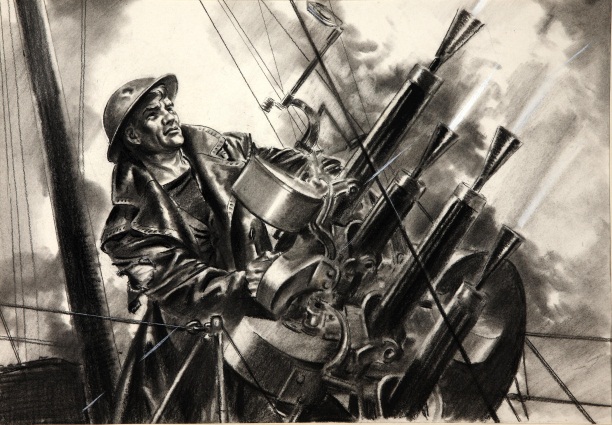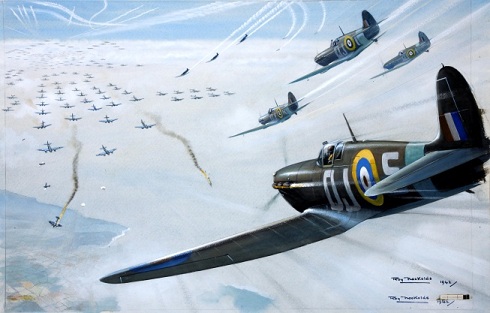Our Keeper’s Gallery currently features a display highlighting the Battle of Britain in 1940. The Battle of Britain was fought between the air forces of Britain and Germany during the Second World War from 10 July to 31 October 1940.
On 16 July Adolf Hitler ordered preparations to be made for the invasion of Britain under the name Operation Sealion. He felt it would first be essential to weaken Britain’s air forces so they wouldn’t be able to oppose invading German troops. On 17 September 1940, plans to invade were postponed after Hitler concluded that Germany could not win the air dominance that it needed. Over the course of the Battle of Britain Germany’s Luftwaffe lost several hundred more planes than the Royal Air Force.
Our display of original artwork highlights two records from the INF 3 series, which includes 1861 pieces of propaganda art produced for the Ministry of Information during the Second World War. It comprises works by dozens of artists in a variety of media.
Jack Foreman Mantle was Acting Leading Seaman on board HMS Foylebank during the Second World War. This artist’s impression shows him operating his pom-pom gun.
On 4 July 1940, just before the official start of the Battle of Britain, HMS Foylebank was attacked in Portland harbour by German dive bombers and incurred numerous hits. Mantle continued in action although mortally injured. He was posthumously awarded the Victoria Cross, Britain’s highest gallantry award. This original artwork was commissioned by the Ministry of Information for a pamphlet to illustrate the bravery of the British people in wartime.
The second artwork shows a diving squadron of spitfires attacking a formation of German bombers. Although the piece has been dated 1942 by the artist this is almost certainly a depiction of the Battle of Britain.
This artwork is by London-born artist Roy Nockolds (1911-1979). Described as one of the pioneers of motoring art, Nockolds began sketching and drawing motoring subjects in the mid 1920s, contributing illustrations to Autocar, Motor, and Motor Sport magazines.
The Battle of Britain display is in the Keeper’s Gallery until February 2016.


Whilst they were fighting for the Royal Air Force members of the ‘British Empire’ and German-occupied countries (e.g. Czechoslovakia and Poland) took part in an effort to stop Nazi-Germany. Although Germany lost a lot of planes we (RAF) had big losses and had Germany not stopped bombing our airfields the result could have been much worse and ‘Britain’ could have lost the battle.
[…] Keeper’s Gallery: Battle of Britain 1940 […]
James Nicolson was awarded a VC for his actions in the Battle of Britain. His was the only VC awarded to Fighter Command during the war. He was later killed in the Far East when he was an observer in a B24 Liberator bomber which ditched in the Bay of Bengal, in support of the effort to retake Rangoon. My father was one of two survivors of the crash.
Do not forget the Belgians .14 were among ‘the FEW’ with 21 confirmed victories. Six did not survive WW2 as about 200 of the 640 Belgians who joined the RAF.
I would like the film about the making of the Spitfires to be available online – behind the pilots was an army of people making those planes! Were there ever any pictures or photographs of the factories?
Mother and I bombed out in the attacks on Bristol, home destroyed at Broomhill Road, Brislington, Bristol 1940, when a German Bomber was shotdown and crashed on the public highway in front of our house which was then inhabitable. Father a Regular Soldier before the War, and lucky to escape at Dunkirk by swimming out to sea and being eventually picked up by British ship. Arrived home unnounced with the same clothes on he had when leaving Dunkirk, nicely shrunk from the Channel seawater, and a Return Ralway Ticket to rejoin his Unit after a week’s Leave. After Leave he went to North Africa Campaign with The Eighth Army, and with them through Egypt & up through Italy and ended his service in Germany.